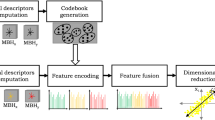Abstract
Gait-based human identification aims to discriminate individuals by the way they walk. A unique advantage of gait as a biometric is that it requires no subject contact and is easily acquired at a distance, which stands in contrast to other biometric techniques involving face, fingerprints, iris, etc. This paper proposes a new gait representation called motion energy image (MEI). Compared with other gait features, MEI is more robust against noise that can be included in binary gait silhouette images due to various factors. The effectiveness of the proposed method for gait recognition is demonstrated using experiments performed on the NLPR database.
Similar content being viewed by others
References
S. Hong, H. Lee, K. Oh, M. Park, and E. Kim, “Gait recognition using sampled point vectors,” Proc. SICE-ICCAS2006, pp. 3937–3940, Oct. 2006.
D. Gavrila, “The visual analysis of human movement: a survey,” Computer Vision and Image Understanding, vol. 73, no. 1, pp. 82–98, 1999.
M. Ekinci, “Gait recognition using multiple projections,” Proc. Int. Conf. Automatic Face and Gesture Recognition, pp. 517–522, 2006.
A. Bazin and M. Nixon, “Gait verification using probabilistic methods,” Proc. IEEE Workshop on Applications of Computer Vision, pp. 60–65, 2005.
A. Bobick and A. Johnson, “Gait recognition using static activity-specific parameters,” Proc. IEEE Computer Vision and Pattern Recognition, pp. 423–430, 2001.
C. BenAbdelkader, R. Culter, H. Nanda, and L. Davis, “Eigengait: motion-based recognition of people using image self-similarity,” Proc. Int’l Conf. Audio-and Video-Based Biometric Person Authentication, pp. 284–294, 2001.
A. Kale, A. N. Rajagopalan, N. Cuntoor, V. Kruger, and R. Chellappa, “Identification of humans using gait,” IEEE Trans. on Image Processing, pp. 1163–1173, Sept. 2004.
R. Collins, R. Gross, and J. Shi, “Silhouette-based human identification from body shape and gait,” Proc. Int’l Conf. Automatic Face and Gesture Recognition, pp. 366–371, 2002.
L. Wang, T. Tan, H. Ning, and W. Hu, “Silhouette analysis-based gait recognition for Human Identification,” IEEE Trans. on Pattern Analysis and Machine Intelligence, vol. 25, pp. 1505–1518, 2003.
T. Lam and R. Lee “A new representation for human gait recognition: Motion Silhouettes Image (MSI),” Proc. Int. Conf. Biometric, pp.612–618, 2006.
J. Han and B. Bhanu, “Individual recognition using gait energy image,” IEEE Trans. on Pattern Analysis and Machine Intelligence, vol. 28, pp. 316–322, 2006.
T. Horpraser, D. Harwood, and L. Davis, “A statistical approach for real-time robust background subtraction and shadow detection,” Proc. IEEE Int. Conf. Computer Vision, 1999.
T. Cover and P. Hart, “Nearest neighbor pattern classification,” IEEE Trans. on Information Theory, vol. 13, pp. 21–27, 1967.
L. Lee and W. Grimson, “Gait analysis for recognition and classification,” Proc. Int’l Conf. Automatic Face and Gesture Recognition, pp. 155–162, 2002.
P. Phillips, S. Sarkar, I. Robledo, P. Grother, and K. Bowyer, “Baseline results for challenge problem of human ID using gait analysis,” Proc. Int’l Conf. Automatic Face and Gesture Recognition, pp. 137–142, 2002.
A. Kale, N. Cuntoor, B. Yegnanarayana, A. N. Rajagopalan, and R. Chellappa, “Gait analysis for human identification,” Proc. Int’l Conf. Audio-and Video-Based Biometric Person Authentication, pp. 706–714, 2003.
Author information
Authors and Affiliations
Corresponding author
Additional information
Recommended by Editorial Board member Jang Myung Lee under the direction of Editor Jae-Bok Song. This work was supported by the Korea Science and Engineering Foundation (KOSEF) through the Biometrics Engineering Research Center (BERC) at Yonsei University. Grant Number: R11-2002-105-09002-0 (2009).
Heesung Lee received the B.S. and M.S. degrees in Electrical and Electronic Engineering, from Yonsei University, Seoul, Korea, in 2003 and 2005, respectively. He is currently a Ph.D. candidate of Dept. of Electrical and Electronic Engineering at Yonsei University. His current research interests include computational intelligence, pattern recognition, biometrics, and neural network.
Sungjun Hong received the B.S. degrees in Electrical and Electronic Engineering and Computer Science, from Yonsei University, Seoul, Korea, in 2005. He is a graduate student of the combined master’s and doctoral degree programs at Yonsei University. He has studied machine learning, biometrics and optimization
Imran Fareed Nizami received the B.S. degree from University of Engg. & Tech. Taxila, Pakistan and the M.S. degree in the Electrical and Electronic Engineering from Yonsei University, Seoul, Korea. He is currently a senior lecturer in Bahria University, Islamabad, Pakistan. His research interests include biometrics, gait recognition, Bayesian and neural networks.
Euntai Kim received the B.S. (with top honors), M.S. and Ph.D. degrees in Electronic Engineering from Yonsei University, Seoul, Korea, in 1992, 1994, and 1999, respectively. From 1999 to 2002, he was a Full-time Lecturer with the Department of Control and Instrumentation Engineering at Hankyong National University, Gyeonggi-do, Korea. Since 2002, he has been with the School of Electrical and Electronic Engineering at Yonsei University, where he is currently an associate professor. He was a Visiting Scholar with the University of Alberta, Edmonton, Canada, and the Berkeley Initiative in Soft Computing (BISC), UC Berkeley, USA, in 2003 and 2008, respectively. His current research interests include computational intelligence and machine learning and their application to intelligent service robots, unmanned vehicles, home networks, biometrics, and evolvable hardware.
Rights and permissions
About this article
Cite this article
Lee, H., Hong, S., Nizami, I.F. et al. A noise robust gait representation: Motion energy image. Int. J. Control Autom. Syst. 7, 638–643 (2009). https://doi.org/10.1007/s12555-009-0414-2
Received:
Revised:
Accepted:
Published:
Issue Date:
DOI: https://doi.org/10.1007/s12555-009-0414-2




